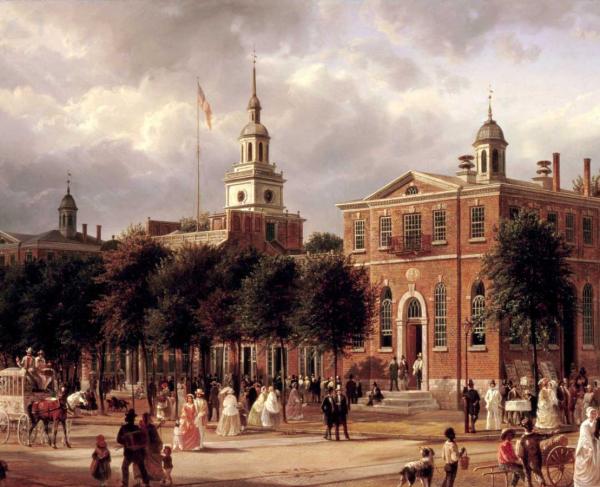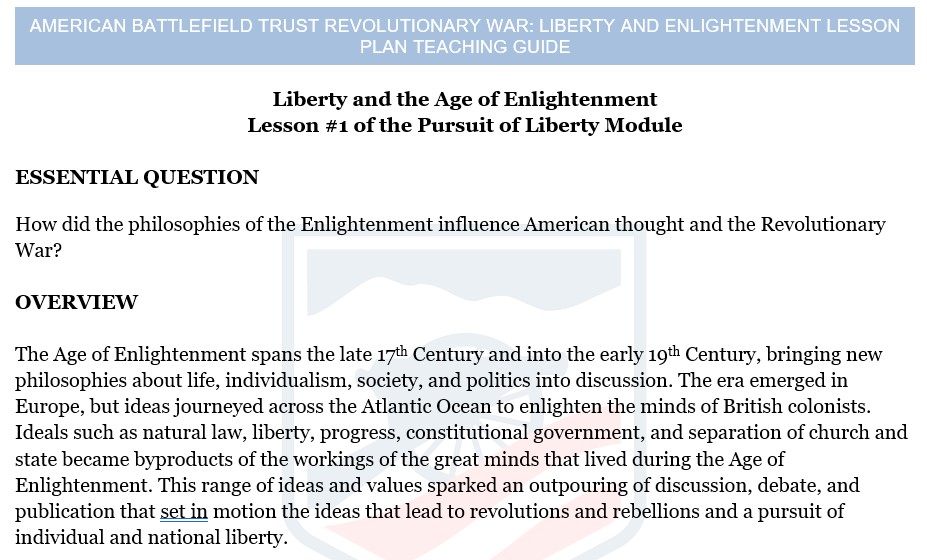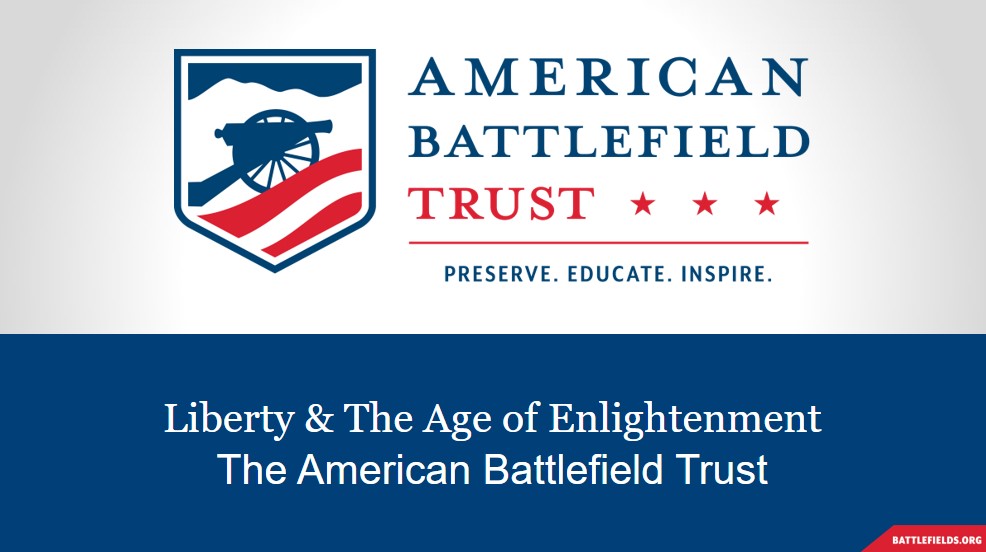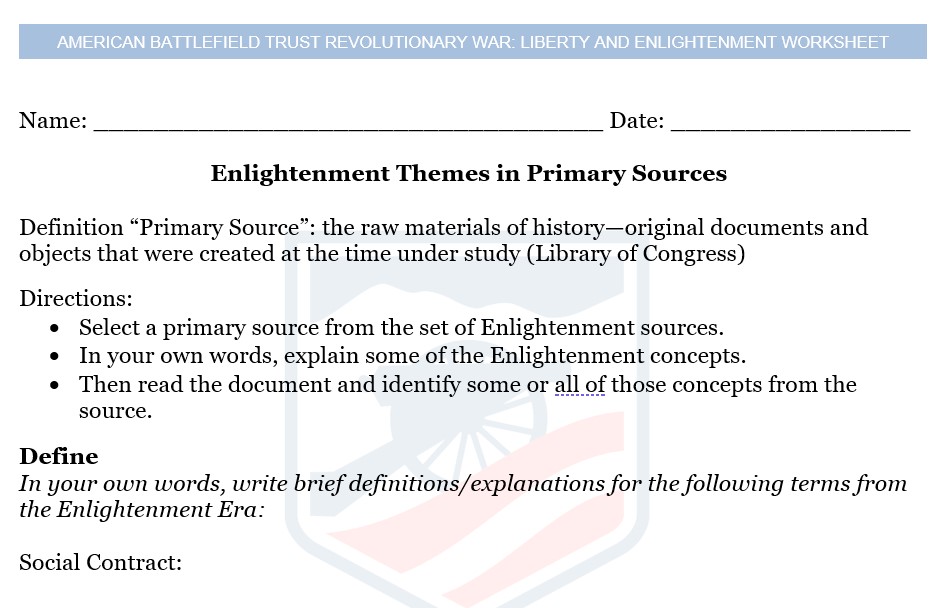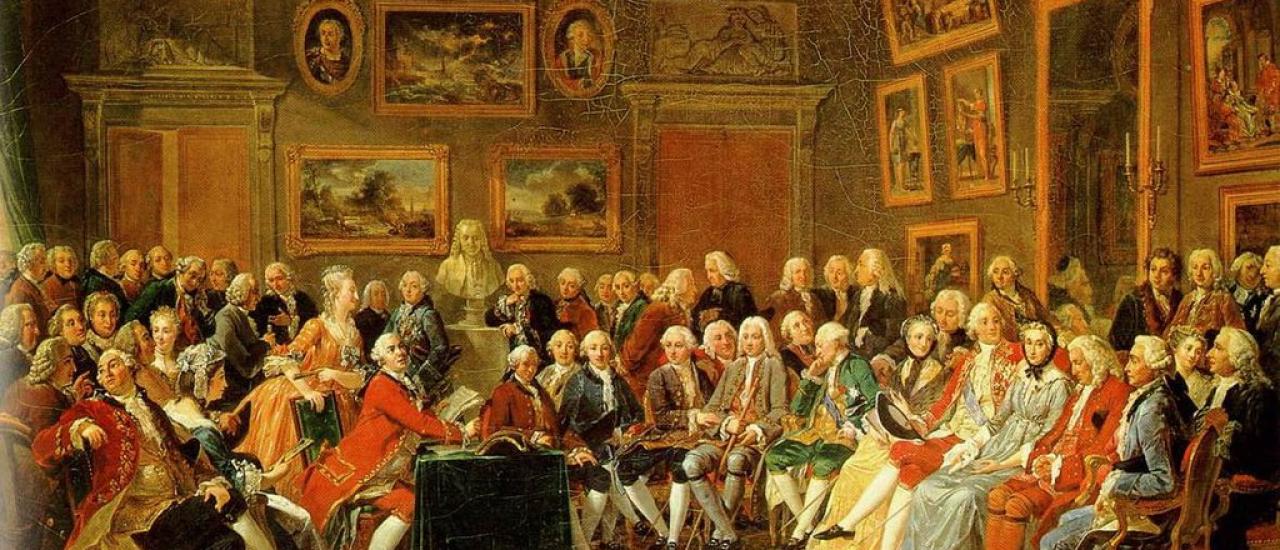
Reading of Voltaire's tragedy of the Orphan of China in the salon of Marie Thérèse Rodet Geoffrin in 1755, by Anicet Charles Gabriel Lemonnier, c. 1812.
Liberty & The Age of Enlightenment Lesson Plan
A lesson plan for use in middle and high school classrooms.
The Age of Enlightenment spans the late 17th Century and into the early 19th Century, bringing new philosophies about life, individualism, society, and politics into discussion. The era emerged in Europe, but ideas journeyed across the Atlantic Ocean to enlighten the minds of British colonists. Ideals such as natural law, liberty, progress, constitutional government, and separation of church and state became byproducts of the workings of the great minds that lived during the Age of Enlightenment. This range of ideas and values sparked an outpouring of discussion, debate, and publication that set in motion the ideas that lead to revolutions and rebellions and a pursuit of individual and national liberty.
This Lesson Plan can be used as a prepared resource by following this curriculum plan which aligns to NCSS and Common Core Standards.
This Lesson Plan's assets can also be used on their own as supplemental resources. The display format is prepared for easy access, exploring, and learning.
The Pursuit of Liberty Module
Upon completion of this lesson, the students will be able to:
1. Knowledge
- Describe some of Age of Enlightenment philosophies, particularly social contract and liberty.
- Discuss some of the Enlightenment philosophers in Europe and America.
2. Comprehension/Application/Analysis
- Examine a primary source and track some of the Enlightenment themes in the document
3. Evaluation
- Evaluate the meaning of Enlightenment terms and how they were put into discussion and practice.
Check out the Lesson Plan Teaching Guide for more instructions on using the prepared Lesson Plan.
Lesson Plan Primary Source Activity:
- Use the Lesson’s PowerPoint to explore the context and history; the PowerPoint introduces Essential Questions and lays foundational knowledge about the conflict.
- Distribute the primary source worksheet.
- Discussing definitions to be written on the worksheet can be done as a class, in small groups, or individually. (Social Contract, Liberty, Individualism, Separation of Power)
- Let the students select a primary source to read and examine with the worksheet.
- A selection of primary sources is available on the Lesson Plan Page for this purpose.
- Have the students complete the primary source worksheet; they can share some of the details that stood out to them with the class.
OPTIONAL HOMEWORK/ASSESSMENT/ADDITIONAL ACTIVITIES:
Option 1: Thomas Paine
Students can use the following resources to learn about Thomas Paine and some of his famous writings that inspired and sustained the American Revolution.
Next have the students write a letter as though they are corresponding with Thomas Paine, offering compliments, asking questions, or even debating his ideas. (The exchange of letters and written thoughts was a key element of the Enlightenment Era.)
Option 2: Enlightenment Meets Civics!
Ask the students to select several government theories or concepts from the Enlightenment Era. (See list on Slide 4 of the PowerPoint, if you need ideas.) Then, facilitate a class discussion about how these ideas are at work in local, state, and/or national government. Do they work well? If they do not work well, should the idea be replaced and with what new idea? What might be the benefits of continuing with the concept or the benefits of something new?
Common Core State Standards- ELA & History/Social Studies
Grades 6-8
- Key Ideas and Details:
- CCSS.ELA-LITERACY.RH.6-8.2
- Determine the central ideas or information of a primary or secondary source; provide an accurate summary of the source distinct from prior knowledge or opinions.
- CCSS.ELA-LITERACY.RH.6-8.3
- Identify key steps in a text's description of a process related to history/social studies (e.g., how a bill becomes law, how interest rates are raised or lowered).
- CCSS.ELA-LITERACY.RH.6-8.2
- Craft and Structure:
- CCSS.ELA-LITERACY.RH.6-8.4
- Determine the meaning of words and phrases as they are used in a text, including vocabulary specific to domains related to history/social studies.
- CCSS.ELA-LITERACY.RH.6-8.4
- Integration of Knowledge and Ideas:
- CCSS.ELA-LITERACY.RH.6-8.8
- Distinguish among fact, opinion, and reasoned judgment in a text.
- CCSS.ELA-LITERACY.RH.6-8.8
Grades 9-10
- Key Ideas and Details:
- CCSS.ELA-LITERACY.RH.9-10.1
- Cite specific textual evidence to support analysis of primary and secondary sources, attending to such features as the date and origin of the information.
- CCSS.ELA-LITERACY.RH.9-10.2
- Determine the central ideas or information of a primary or secondary source; provide an accurate summary of how key events or ideas develop over the course of the text.
- CCSS.ELA-LITERACY.RH.9-10.1
- Craft and Structure:
- CCSS.ELA-LITERACY.RH.9-10.4
- Determine the meaning of words and phrases as they are used in a text, including vocabulary describing political, social, or economic aspects of history/social science.
- CCSS.ELA-LITERACY.RH.9-10.5
- Analyze how a text uses structure to emphasize key points or advance an explanation or analysis.
- CCSS.ELA-LITERACY.RH.9-10.4
- Integration of Knowledge and Ideas:
- CCSS.ELA-LITERACY.RH.9-10.8
- Assess the extent to which the reasoning and evidence in a text support the author's claims.
- CCSS.ELA-LITERACY.RH.9-10.8
Grades 11-12
- Key Ideas and Details:
- CCSS.ELA-LITERACY.RH.11-12.2
- Determine the central ideas or information of a primary or secondary source; provide an accurate summary that makes clear the relationships among the key details and ideas.
- CCSS.ELA-LITERACY.RH.11-12.2
- Craft and Structure:
- CCSS.ELA-LITERACY.RH.11-12.4
- Determine the meaning of words and phrases as they are used in a text, including analyzing how an author uses and refines the meaning of a key term over the course of a text (e.g., how Madison defines faction in Federalist No. 10).
- CCSS.ELA-LITERACY.RH.11-12.5
- Analyze in detail how a complex primary source is structured, including how key sentences, paragraphs, and larger portions of the text contribute to the whole.
- CCSS.ELA-LITERACY.RH.11-12.4
- Integration of Knowledge and Ideas:
- CCSS.ELA-LITERACY.RH.11-12.8
- Evaluate an author's premises, claims, and evidence by corroborating or challenging them with other information.
- CCSS.ELA-LITERACY.RH.11-12.8
Social Studies - National Council for the Social Studies
- Theme 1: Culture
- Theme 2: Time, Continuity, and Change
- Theme 5: Individuals, Groups, and Institutions
- Theme 6: Power, Authority, and Governance
- Theme 8: Science, Technology, and Society
- Theme 9: Global Connections
- Theme 10: Civic Ideals and Practices
This Lesson plan
contains the following:
3 Activities | 23 Resources
Audience: Middle school | High school
This Lesson plan is a part of:
Revolutionary War Curriculum | The Pursuit of Liberty Module
